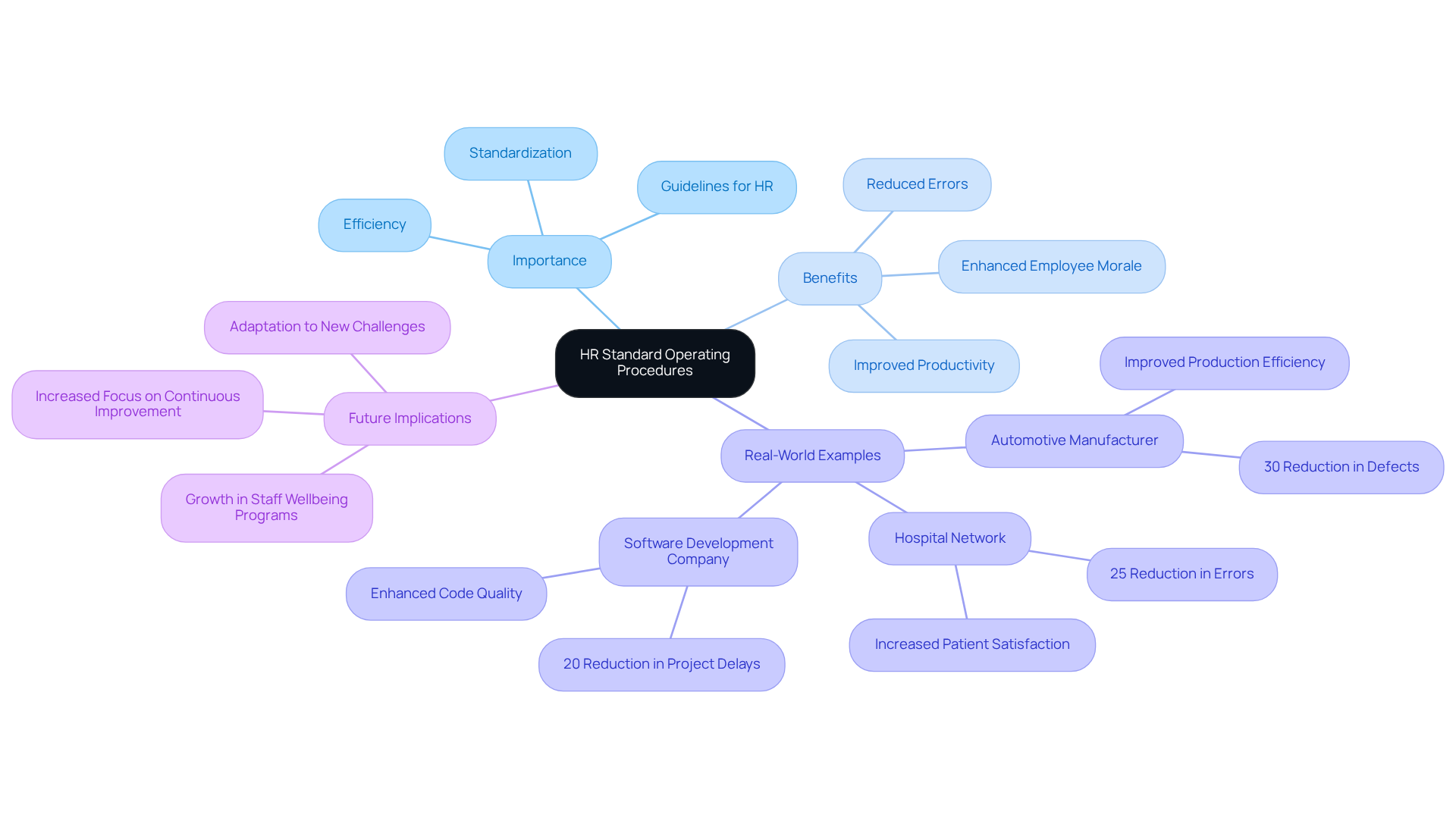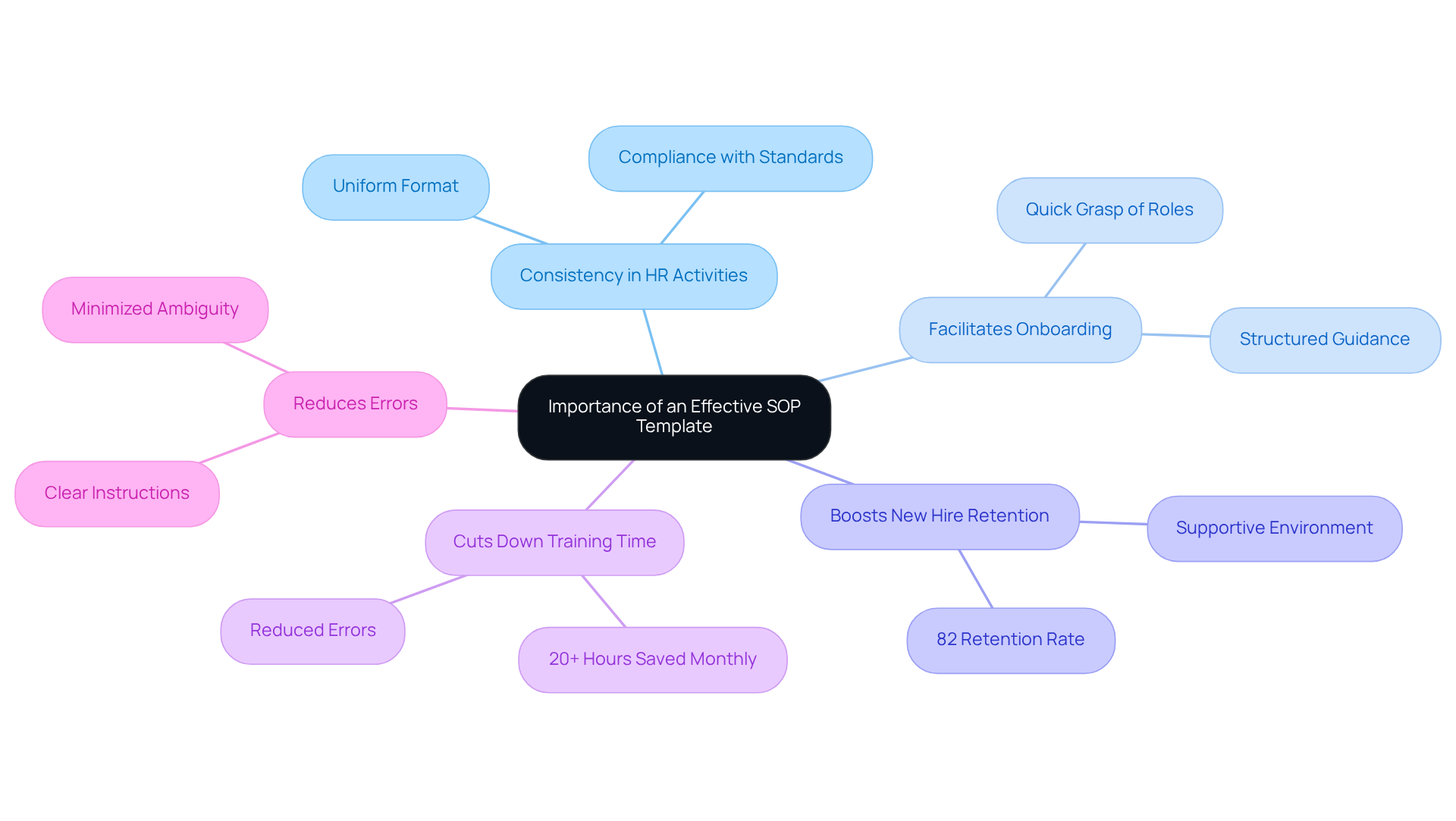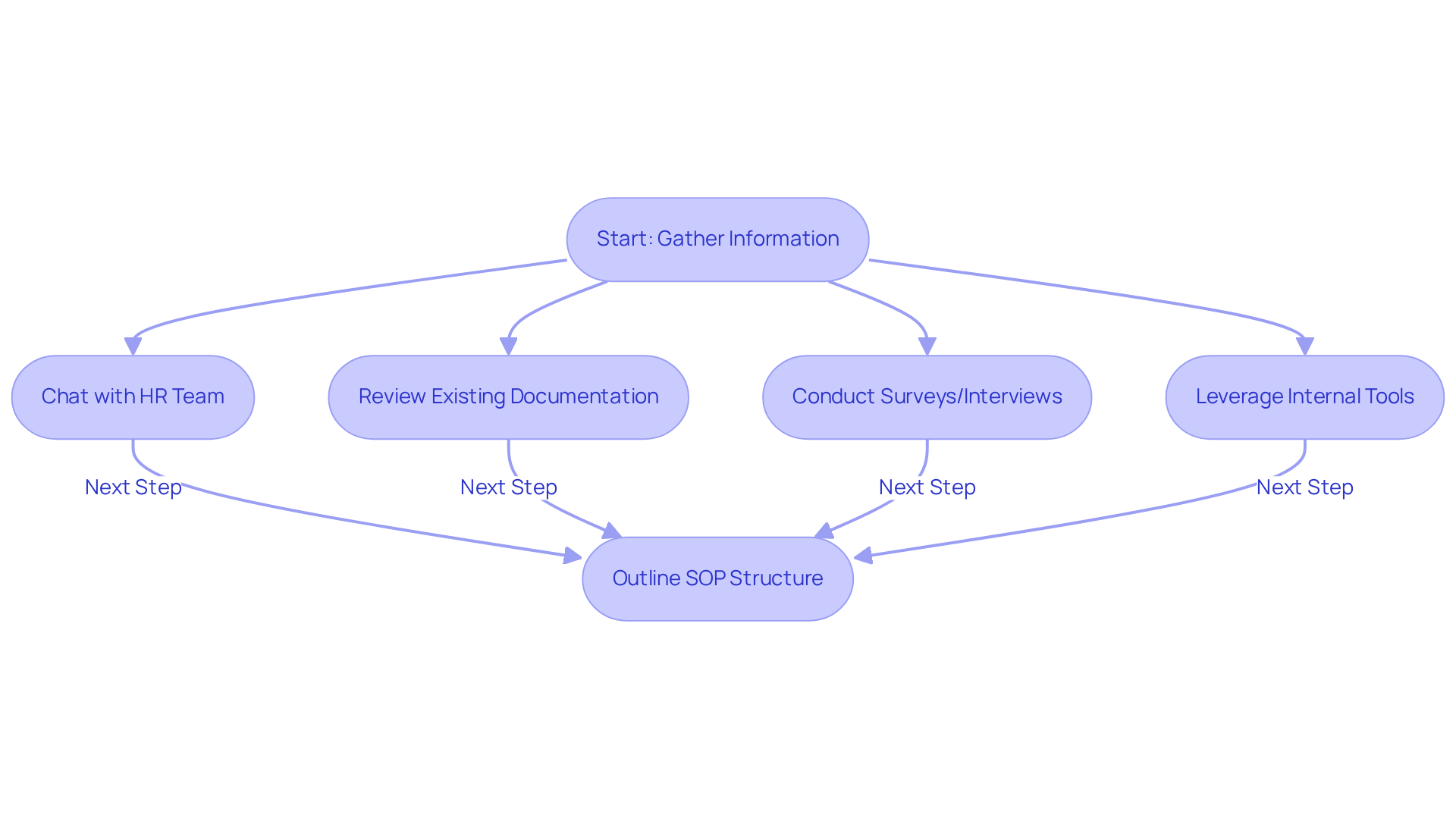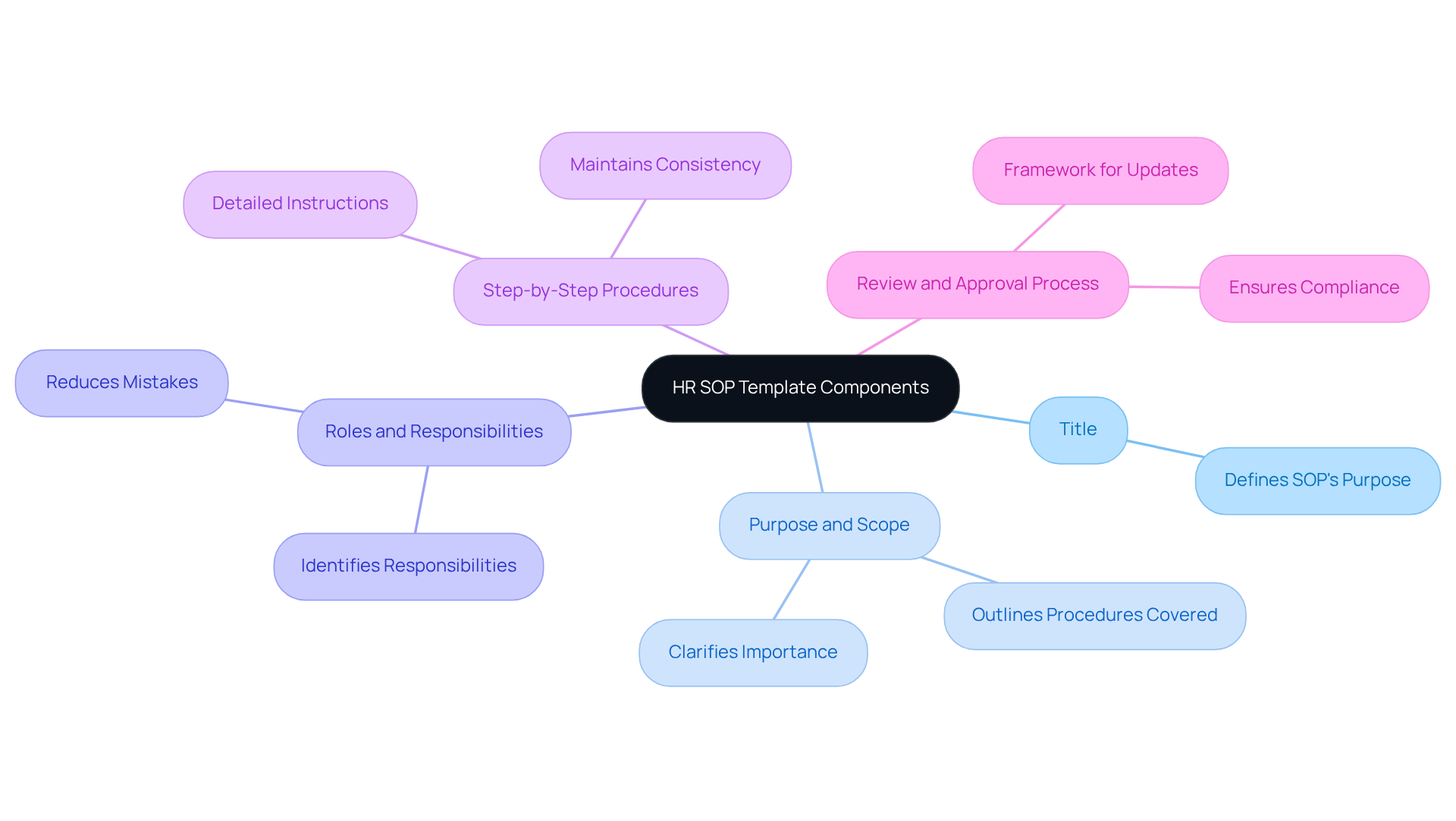
Overview
You might be wondering how to create an effective HR Standard Operating Procedure (SOP) template. Well, it’s all about documenting clear guidelines that cover key HR functions. This not only standardizes practices but also boosts efficiency and compliance. Speaking of which, it’s crucial to involve stakeholders in this process. Their input can make a real difference!
Now, let’s dive into what makes a great SOP. It’s important to include detailed components and ensure there’s ongoing training and feedback. These elements really contribute to improved organizational performance and can even help with employee retention. So, as you think about your own documentation challenges, consider how these strategies can make a positive impact on your organization.
Key Highlights:
- HR Standard Operating Procedures (SOPs) provide documented guidelines for HR teams, covering recruitment, onboarding, performance management, and employee relations.
- Standardising HR practises helps reduce errors and boosts efficiency, with documented procedures supporting organisational growth.
- A well-defined SOP template aligns HR personnel and fosters a culture of continuous improvement, crucial for adapting to future challenges.
- Real-world examples show that standardised HR procedures can lead to significant operational improvements, such as reduced defects and errors in organisations.
- An effective SOP template ensures compliance with legal standards and facilitates onboarding, improving new hire retention by up to 82%.
- Gathering input from stakeholders enhances the quality and relevance of SOPs, while reviewing existing documentation ensures alignment with organisational standards.
- Key components of an SOP template include title, purpose, roles and responsibilities, step-by-step procedures, and a review process for ongoing updates.
- Training HR teams on SOP usage and incorporating feedback are essential for refining procedures and maintaining their relevance in a changing environment.
Introduction
Creating a solid HR standard operating procedure (SOP) template is super important for organizations looking to streamline their human resource practices. You might be wondering how establishing clear guidelines can really make a difference. Well, by doing so, HR teams can boost efficiency, cut down on errors, and nurture a culture of continuous improvement. But here’s the thing: as businesses grow and face new challenges, how can HR leaders keep their SOPs relevant and effective in such a fast-paced environment?
Now, let’s dive into the five crucial steps to develop an HR SOP template that not only meets today’s demands but also sets organizations up for future growth.
Define HR Standard Operating Procedures
HR Standard Operating Procedures (SOPs), also known as the hr standard operating procedure template, serve as the playbook for HR teams by providing essential documented guidelines that outline the specific processes and policies they need to follow. You might be wondering why this matters. Well, these procedures cover a range of HR functions, from recruitment and onboarding to performance management and employee relations. By utilizing an hr standard operating procedure template, organizations can standardize their HR practices, which helps reduce errors and boosts overall efficiency. For instance, did you know that small businesses experiencing rapid growth are 75% more likely to document performance improvement strategies for their underperforming employees? This highlights just how crucial standard procedures are in supporting growth.
Now, let’s think about what a well-defined hr standard operating procedure template accomplishes. It serves as a vital reference point for HR personnel, ensuring that everyone on the team is on the same page when it comes to managing human resources effectively. This alignment is especially important as we look ahead to 2025, where organizations will face new challenges and expectations from both employees and leadership. Experts point out that the biggest benefits of documented HR procedures often unfold over time, as they become a part of daily operations, helping to foster a culture of continuous improvement. Nikhil Agarwal, who has worked with over 300 companies since 2012, really emphasizes how transformative the hr standard operating procedure template can be for operational excellence.
But wait, there’s more! The impact of documented HR procedures on organizational efficiency is huge. For example, a well-known automotive manufacturer that standardized its HR procedures saw a 30% drop in defects and improved production efficiency. Similarly, a large hospital network managed to reduce errors by 25% by implementing standardized patient admission and discharge procedures. These real-world examples show that effective HR procedures not only streamline operations but also enhance the organization’s reputation and boost employee morale.
In conclusion, defining and implementing an HR standard operating procedure template isn’t just a box-checking exercise; it’s a strategic move that sets organizations up for success in a competitive landscape. By prioritizing the creation of clear, actionable procedures, HR leaders can ensure their teams are ready to tackle the demands of the modern workplace while fostering an environment of growth and engagement. If you’re curious to learn more about SOPs, don’t miss the upcoming webinar titled 'Scaling Without Chaos - The Power of Process Standardization'—it’s packed with valuable insights!

Understand the Importance of an Effective SOP Template
You might be wondering why an effective SOP outline is such a big deal. Well, for starters, the HR standard operating procedure template establishes a uniform format that ensures all the essential information is recorded consistently across various HR activities. This consistency is super important for staying compliant with legal and organizational standards, especially as regulations keep changing in 2025. Plus, a well-organized HR standard operating procedure template facilitates onboarding for new HR personnel, helping them quickly grasp their roles and responsibilities. Did you know that organizations with standardized onboarding procedures can boost new hire retention by up to 82%? That's a game changer!
Now, let’s dive into how SowFlow’s instant documentation solution can help HR teams whip up and update user guides with ease, keeping all processes relevant and accessible. And here’s another perk: having a clear HR standard operating procedure template can really cut down on training time and reduce the chances of errors, making HR operations run more smoothly. In fact, organizations that embrace standard operating procedures often save over 20 hours a month on training and quick inquiries. That’s not just efficient; it’s a smart move!
As HR specialists face challenges like burnout, efficient SOPs can lighten the load by offering clarity and organization. And with SowFlow, knowledge sharing and standardization become a breeze, making your life just a little bit easier.

Gather Necessary Information and Resources
Are you looking to create an effective HR standard operating procedure template? Well, you’ve come to the right place! Start by gathering all the essential information and resources you’ll need. It’s super helpful to chat with HR team members, managers, and other stakeholders. This way, you’ll get a solid grasp of the specific procedures that need documentation. Research shows that organizations that involve stakeholders in this process see a big boost in the quality and relevance of their SOPs.
Now, don’t skip the step of reviewing existing documentation, policies, and best practices. This is crucial to ensure everything aligns with your organizational standards. You might consider using tools like surveys and interviews to gather valuable insights from those directly involved in the processes. Plus, leveraging internal wikis or collaboration tools can really help with ongoing updates and keeping everyone engaged. This comprehensive approach not only sets a strong foundation for your HR standard operating procedure template but also fosters a collaborative atmosphere that enhances the quality and relevance of your documentation.
Once you’ve collected all this information, the next step is to outline the essential elements of your SOP structure. Speaking of that, let’s dive into what those elements might look like!

Outline Key Components of the SOP Template
When you're creating your hr standard operating procedure template, you might be wondering what key components to include for clarity and usability. Here’s a friendly guide to help you out:
- Title: Start with a clear title that defines the SOP's purpose. This gives immediate context and sets the stage for what's to come.
- Purpose and Scope: Next, clarify why this SOP matters and outline the procedures it covers. This helps users grasp its significance right off the bat.
- Roles and Responsibilities: It's crucial to identify who’s responsible for each step in the process. This section is essential because well-defined roles can reduce mistakes and boost productivity—everyone knows what they need to do.
- Step-by-Step Procedures: Provide detailed, actionable instructions for each task. Clarity here is key for maintaining consistency across departments and aiding employee training. Have you heard about SowFlow's instant documentation solution? It’s a game changer for enhancing this workflow, allowing effortless updates so your SOPs stay relevant in a fast-paced business environment. Features like automated screenshot capture and in-browser editing really elevate the user guide creation experience.
- Review and Approval Process: Finally, set up a framework for how the SOP will be reviewed and updated over time. This ensures it remains relevant and compliant with any regulatory changes. SowFlow makes it easy for teams to access documentation, facilitating the sharing and standardization of procedures throughout your organization.
Incorporating these components not only makes your hr standard operating procedure template comprehensive but also user-friendly, ultimately leading to improved organizational efficiency and effectiveness. Plus, don’t underestimate the power of visual aids like flowcharts—they can really enhance understanding. And hey, being mindful of common pitfalls in SOP development can help you steer clear of mistakes. Remember, well-organized standard operating procedures streamline processes and keep information consistent across departments, significantly benefiting your organization. As Anastasia Masadi, a Product Owner, puts it, "SowFlow has been a game changer in the way we document work and deliver to our clients. I do not have to take each screenshot separately, and do not even have to leave the browser while I am creating SOPs and training materials. SowFlow gave me time from my life back.

Implement and Refine the SOP Template
So, you've developed your HR standard operating procedure template—what should you do next? The next big step is rolling it out across your organization. You might be wondering how to kick things off. Start by providing thorough training for your HR team on how to effectively use the HR standard operating procedure template. It's super important to emphasize why sticking to these procedures matters. Did you know that organizations with structured onboarding processes see a whopping 50% boost in productivity? That's something worth sharing!
Now, to make the training really stick, think about incorporating practical examples and hands-on sessions. This way, your team can see how the HR standard operating procedure template functions in real-life situations. Once your standard operating procedures are in action, don't forget to gather feedback from the users. Statistics reveal that 86% of HR managers believe training is key to keeping employees around, highlighting the importance of continuous improvement.
By consistently assessing and enhancing your HR standard operating procedure template based on user input, you'll keep it relevant and efficient as your organization evolves. This ongoing process not only elevates the quality of your HR procedures but also fosters a culture of engagement and commitment among your staff. After all, employees who feel supported are ten times more likely to stick around. So, by prioritizing training and feedback, you can ensure your HR SOPs remain a valuable resource for your team!

Conclusion
You might be wondering why establishing an effective HR standard operating procedure (SOP) template is such a big deal. Well, for any organization looking to streamline its human resource functions and boost operational efficiency, it’s absolutely essential! By clearly defining procedures and sticking to them, organizations can not only cut down on errors but also nurture a culture of continuous improvement. This strategic approach empowers HR teams to tackle the evolving challenges of today’s workplace, ultimately paving the way for organizational success.
Now, let’s take a moment to reflect on the key insights shared throughout this article about crafting a well-structured HR SOP template. We’ve talked about the importance of:
- Gathering relevant information
- Outlining critical components
- Rolling out the SOP effectively within your organization
Real-world examples have shown us the tangible perks of standardized procedures, like improved productivity and fewer mistakes, reinforcing the idea that a solid SOP is a powerful ally for HR teams.
As you navigate the complexities of human resource management, prioritizing the development and refinement of HR SOPs is becoming more crucial than ever. By investing in these procedures, HR leaders can not only boost their team’s performance but also significantly enhance employee satisfaction and retention. Embracing the principles we’ve outlined can lay the groundwork for a more organized, efficient, and engaged workforce, setting the stage for long-term success. So, are you ready to dive in and make your HR SOPs work for you?
Frequently Asked Questions
What are HR Standard Operating Procedures (SOPs)?
HR Standard Operating Procedures (SOPs) are documented guidelines that outline the specific processes and policies that HR teams need to follow, covering functions such as recruitment, onboarding, performance management, and employee relations.
Why are HR SOPs important for organizations?
HR SOPs help standardize HR practices, reduce errors, and boost overall efficiency. They serve as a vital reference for HR personnel, ensuring alignment in managing human resources effectively, especially in the face of new challenges and expectations.
How do documented HR procedures impact organizational efficiency?
Documented HR procedures can significantly enhance organizational efficiency. For example, a standardized HR process in an automotive manufacturer led to a 30% drop in defects, while a hospital network reduced errors by 25% through standardized patient admission and discharge procedures.
What benefits do organizations gain from using an HR standard operating procedure template?
Organizations benefit from improved compliance with legal standards, better onboarding processes, increased new hire retention, reduced training time, and minimized errors in HR operations.
How does a well-organized HR SOP template facilitate onboarding?
A well-organized HR SOP template helps new HR personnel quickly understand their roles and responsibilities, contributing to a smoother onboarding experience and boosting new hire retention by up to 82%.
What is the role of SowFlow in HR SOP documentation?
SowFlow provides an instant documentation solution that helps HR teams create and update user guides easily, ensuring that all processes remain relevant and accessible, thus improving efficiency and reducing training time.
What impact do effective SOPs have on HR specialists facing challenges like burnout?
Efficient SOPs provide clarity and organization, which can help alleviate the workload of HR specialists, making their roles more manageable and reducing the risk of burnout.
👍
What others are liking
5 Steps to outline your ideal documentation structure
5 MINS READ
Where to start the your journey of mapping out your ideal documentation structure, aligning it with the very heartbeat of your organization?
Defining a winning level of detail in your process
3 MINS READ
What is too much detail, and what is too little? This article described in that winning level detail about what detail is enough.





